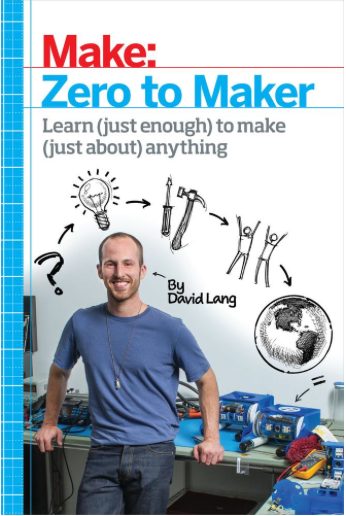I was very fortunate to grow up in a house where both parents were the hands-on, DIYer-types. My dad taught me a good bit of woodworking and some home repair, and my mom was more of a crafter, always having a project or two for us kids to do side-by-side with her as she sewed or glued or painted. I think it was inevitable that I would also develop that desire to tinker, fix, and create.
I kept thinking how lucky I was to get this head start from my parents as I read through the new book, Zero to Maker, written by David Lang. I’ve been looking forward to this book for some time now — I read the early blog posts by David over at makezine.com when he started the column that would follow him as he took on the task to learn new skills and tools over a 30 day period. It was fascinating to read his first-hand accounts that started back in August 2011 with his Enough to be Dangerous post. Fortunately, David didn’t stop after his 30-day experiment — he continued posting mostly weekly submissions up to the middle of July 2012. Along the way, readers got to hear David’s thoughts on learning to weld, read about his own OpenROV project, and tag along as he visited various makerspaces around the country.
All of his original posts can be found here, and I encourage you to read all twenty-four posts chronologically. Then, when you’re done and want more, grab a copy of his new book that includes, in addition to completely new material, various snippets from his original posts with updates or additional thoughts and content.
It’s a 200 page book that David ran through Kickstarter (successfully) and has now been published by Maker Media. Throughout the book, David documents not only his own concerns about lacking a background of the skills necessary to become a maker, but he shares plenty of stories of other novice makers who found themselves with the desire to do but lacking the how. Throughout the book, David shares openly and honestly about the loss of his job as a computer jockey. He talks about his first visit to a Maker Faire and being completely overwhelmed while at the same time wanting to be able to mimic the creativity that he saw on display. He explains how he came up with his 30-day experiment and pitched it to Make magazine and then, when the idea was accepted, the realization that he had a lot to learn and not much of an idea for where to start.
The book isn’t just his personal story and those of a few other makers; David offers solid advice for anyone facing this same problem — where to begin? He covers many of the latest buzzwords that so many people are hearing about these days — 3D printers, laser cutters, CAD, and rapid prototyping. He offers advice on achieving a Maker Mentality, and even devotes a chapter on going pro (along with real-life examples of some amazingly successful makers who took an idea they were passionate about turned it into a career). He covers makerspaces, hackerspaces, and FabLabs… and does quite a good job of explaining the differences.
The book isn’t just for adults, either. There’s a great chapter on making more makers — encouraging kids to get their hands dirty and to start tinkering. David’s absolutely correct when he states that kids don’t need a whole lot of encouragement; they’re typically faster at picking up on tools and new skills even faster than the adults.
Here in my hometown there’s a small group of us who have come together in a local coffee shop over the last few months and are slowly but surely looking at creating another makerspace for the Atlanta area. But many of us (myself included) feel strongly this makerspace should be extremely kid-friendly, and David’s book couldn’t have come at a better time because it has some great advice and links to some resources for those of us looking at creating kid-friendly makerspaces.
And since I mentioned resources, I should add that although the book is only about 200 pages, with all the additional links and books that David recommends, I’ve probably got a month’s worth of reading right there. A few of the websites he recommends are easily worth the price of the book alone as I would never have been aware of some of the organizations he points readers towards. (Thanks, David!)
For any existing makerspaces out there, I’d add this bit: buy a dozen or more copies of the book and keep them on-hand to hand over to the newbies that walk in. There is nothing more intimidating (I imagine) than walking into a noisy, busy workspace and not having a clue what’s going on. This book would be a great introduction to this new maker movement for novices and give them some great “I’ve been there” stories that could help dispel some newbie anxiety. The same goes for kids; the book is kid-friendly in its writing style, and really is a fun, fast read.
If anything, the book inspired me as well to finally get my home makerspace more organized and ready. I spent this weekend cleaning out my workshop and moving some tables for better access, hanging things on the pegboard, and taking an inventory of all my tools. I’ve got a few pet projects I’ve been meaning to finish up, and I’ve got a few new ones already in the queue. My boys (ages 6 and 3) are starting to show interest as well, and I’ve got a few small projects in the works for them to get some one-on-one time with their dad. Cannot wait.
If you’ve been wanting to learn some new skills, to start making or fixing or improving something… Zero to Maker is pure inspiration.



